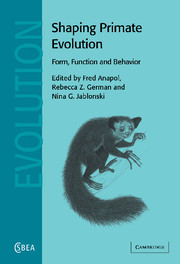Book contents
- Frontmatter
- Contents
- List of contributors
- Preface: shaping primate evolution
- 1 Charles Oxnard: an appreciation
- Part I Craniofacial form and variation
- Part II Organ structure, function, and behavior
- Part III In vivo organismal verification of functional models
- Part IV Theoretical models in evolutionary morphology
- Part V Primate diversity and evolution
- 16 The evolution of primate ecology: patterns of geography and phylogeny
- 17 Charles Oxnard and the aye-aye: morphometrics, cladistics, and two very special primates
- 18 From “mathematical dissection of anatomies” to morphometrics: a twenty-first-century appreciation of Charles Oxnard
- 19 Design, level, interface, and complexity: morphometric interpretation revisited
- 20 Postscript and acknowledgments
- Index
- References
16 - The evolution of primate ecology: patterns of geography and phylogeny
Published online by Cambridge University Press: 10 August 2009
- Frontmatter
- Contents
- List of contributors
- Preface: shaping primate evolution
- 1 Charles Oxnard: an appreciation
- Part I Craniofacial form and variation
- Part II Organ structure, function, and behavior
- Part III In vivo organismal verification of functional models
- Part IV Theoretical models in evolutionary morphology
- Part V Primate diversity and evolution
- 16 The evolution of primate ecology: patterns of geography and phylogeny
- 17 Charles Oxnard and the aye-aye: morphometrics, cladistics, and two very special primates
- 18 From “mathematical dissection of anatomies” to morphometrics: a twenty-first-century appreciation of Charles Oxnard
- 19 Design, level, interface, and complexity: morphometric interpretation revisited
- 20 Postscript and acknowledgments
- Index
- References
Summary
Introduction
Over four decades, Charles Oxnard has been a relentless pioneer in expanding the quantitative horizons of research in primate and human evolution. His many works using multivariate analyses to elucidate and amplify our understanding of the primate shoulder, the primate foot, primate locomotion, prosimians, primate limb proportions, and the relationships of early hominids are well known and widely cited (Ashton et al., 1965, 1975, 1976; Oxnard, 1981, 1984). Less widely cited are his efforts with Robin Crompton and Susan Lieberman to use many of the same quantitative techniques to examine broad patterns in primate behavior and ecology (Crompton et al., 1987; Oxnard et al., 1990). In recent years we have made several efforts to redress this oversight (Fleagle and Reed, 1996, 1999a; Reed, 1999), and it seems particularly appropriate to provide here a general summary of that work. Charles Oxnard is more than a gifted quantitative biologist; he is also a person who delights in reducing the seemingly insurmountable complexity of nature to simple and often esthetically pleasing patterns. Yet, at the same time, he has always been keen to push his analyses one more step and demonstrate that a dataset may yield very different patterns when viewed from a slightly different perspective. Accordingly, in the spirit of Charles's work we will concentrate on some of the broader patterns that emerge from our studies of primate communities when we look at the same dataset from a slightly different perspective.
- Type
- Chapter
- Information
- Shaping Primate EvolutionForm, Function, and Behavior, pp. 353 - 367Publisher: Cambridge University PressPrint publication year: 2004
References
- 4
- Cited by



